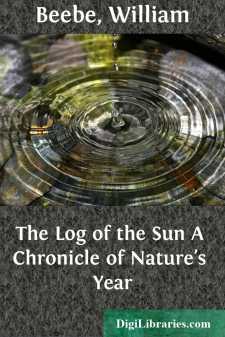Categories
- Antiques & Collectibles 13
- Architecture 36
- Art 48
- Bibles 22
- Biography & Autobiography 813
- Body, Mind & Spirit 141
- Business & Economics 28
- Children's Books 12
- Children's Fiction 9
- Computers 4
- Cooking 94
- Crafts & Hobbies 4
- Drama 346
- Education 46
- Family & Relationships 57
- Fiction 11826
- Games 19
- Gardening 17
- Health & Fitness 34
- History 1377
- House & Home 1
- Humor 147
- Juvenile Fiction 1873
- Juvenile Nonfiction 202
- Language Arts & Disciplines 88
- Law 16
- Literary Collections 686
- Literary Criticism 179
- Mathematics 13
- Medical 41
- Music 40
- Nature 179
- Non-Classifiable 1768
- Performing Arts 7
- Periodicals 1453
- Philosophy 64
- Photography 2
- Poetry 896
- Political Science 203
- Psychology 42
- Reference 154
- Religion 513
- Science 126
- Self-Help 83
- Social Science 81
- Sports & Recreation 34
- Study Aids 3
- Technology & Engineering 59
- Transportation 23
- Travel 463
- True Crime 29
The Log of the Sun A Chronicle of Nature's Year
by: William Beebe
Description:
Excerpt
BIRDS OF THE SNOW
No fact of natural history is more interesting, or more significant of the poetry of evolution, than the distribution of birds over the entire surface of the world. They have overcome countless obstacles, and adapted themselves to all conditions. The last faltering glance which the Arctic explorer sends toward his coveted goal, ere he admits defeat, shows flocks of snow buntings active with warm life; the storm-tossed mariner in the midst of the sea, is followed, encircled, by the steady, tireless flight of the albatross; the fever-stricken wanderer in tropical jungles listens to the sweet notes of birds amid the stagnant pools; while the thirsty traveller in the desert is ever watched by the distant buzzards. Finally when the intrepid climber, at the risk of life and limb, has painfully made his way to the summit of the most lofty peak, far, far above him, in the blue expanse of thin air, he can distinguish the form of a majestic eagle or condor.
At the approach of winter the flowers and insects about us die, but most of the birds take wing and fly to a more temperate climate, while their place is filled with others which have spent the summer farther to the north. Thus without stirring from our doorway we may become acquainted with many species whose summer homes are hundreds of miles away.
No time is more propitious or advisable for the amateur bird lover to begin his studies than the first of the year. Bird life is now reduced to its simplest terms in numbers and species, and the absence of concealing foliage, together with the usual tameness of winter birds, makes identification an easy matter.
In January and the succeeding month we have with us birds which are called permanent residents, which do not leave us throughout the entire year; and, in addition, the winter visitors which have come to us from the far north.
In the uplands we may flush ruffed grouse from their snug retreats in the snow; while in the weedy fields, many a fairy trail shows where bob-white has passed, and often he will announce his own name from the top of a rail fence. The grouse at this season have a curious outgrowth of horny scales along each side of the toes, which, acting as a tiny snowshoe, enables them to walk on soft snow with little danger of sinking through.
Few of our winter birds can boast of bright colours; their garbs are chiefly grays and browns, but all have some mark or habit or note by which they can be at once named. For example, if you see a mouse hitching spirally up a tree-trunk, a closer look will show that it is a brown creeper, seeking tiny insects and their eggs in the crevices of the trunk. He looks like a small piece of the roughened bark which has suddenly become animated. His long tail props him up and his tiny feet never fail to find a foothold. Our winter birds go in flocks, and where we see a brown creeper we are almost sure to find other birds.
Nuthatches are those blue-backed, white or rufous breasted little climbers who spend their lives defying the law of gravity....


